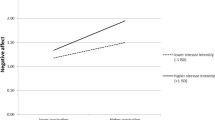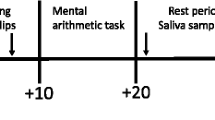Abstract
To test further the sensitivity to aversive events hypothesis, males and females varying in level of depressed mood listened to positive, negative, and neutral social scenes while psychophysiological measurements were obtained. In addition, the relations among response styles, coping strategies, and psychological adjustment were examined. Results indicated that only dysphoric females responded in ways consistent with the sensitivity hypothesis, exhibiting greater electrodermal responses to negative social scenes compared to nondysphoric females. No differences in psychophysiological sensitivity were found between dysphoric and nondysphoric males. Dysphoric students engaged in more ruminative type responses in reaction to their depressed mood and reported using more avoidant coping strategies in response to stress. In particular, females utilized more ruminative strategies in response to a depressed mood and more emotion-focused coping strategies in response to stressful events in general. The implications for these results are discussed within a diathesis-stress framework.
Similar content being viewed by others
References
Barnett, P. A., & Gotlib, I. H. (1988). Psychosocial functioning and depression: Distinguishing among antecedents, concomitants, and consequences.Psychological Bulletin, 104, 97–126.
Beck, A. T. (1978).Beck Depression Inventory. San Antonio, TX: Psychological Corporation.
Beck, A. T., Steer, R. A., & Garbin, M. G. (1988). Psychometric properties of the Beck Depression Inventory: Twenty-five years of evaluation.Clinical Psychology Review, 8, 77–100.
Belsher, G., & Costello, C. G. (1988). Relapse after recovery from unipolar depression: A critical review.Psychological Bulletin, 104, 84–96.
Billings, A. G., & Moos, R. H. (1984). Coping, stress, and social resources among adults with unipolar depression.Journal of Personality and Social Psychology, 46, 877–891.
Billings, A. G., & Moos, R. H. (1985). Psychosocial processes of remission in unipolar depression: Comparing depressed patients with matched community controls.Journal of Consulting and Clinical Psychology, 53, 314–325.
Billings, A. G., Cronkite, R. C., & Moos, R. H. (1983). Social-environmental factors in unipolar depression: Comparisons of depressed patients and nondepressed controls.Journal of Abnormal Psychology, 92, 119–133.
Butler, L. D., & Nolen-Hoeksema, S. (1994). Gender differences in response to depressed mood in a college sample.Sex Roles, 30, 331–346.
Carver, C. S., Scheier, M. F., & Weintraub, J. K. (1989). Assessing coping strategies: A theoretically based approach.Journal of Personality and Social Psychology, 56, 267–283.
Coryell, W., Endicott, J., & Keller, M. (1991). Predictors of relapse into major depressive disorder in a nonclinical population.American Journal of Psychiatry, 148, 1353–1358.
Forrest, M. S., & Hokanson, J. E. (1975). Depression and autonomic arousal reduction accompanying self-punitive behavior.Journal of Abnormal Psychology, 84, 346–357.
Fowles, D. C., Christie, M. J., Edelberg, R., Grings, W. W., Lykken, D. T., & Venables, P. H. (1981). Publication recommendations for electrodermal measurements.Psychophysiology, 18, 232–239.
Frank, E., Kupfer, D. J., & Perel, J. M. (1989). Early recurrence in unipolar depression.Archives of General Psychiatry, 46, 397–400.
Gatchel, R. J., McKinney, M. E., & Koebernick, L. F. (1977). Learned helplessness, depression, and physiological responding.Psychophysiology, 14, 25–31.
Hamilton, S., & Fagot, B. I. (1988). Chronic stress and coping styles: A comparison of male and female undergraduates.Journal of Personality and Social Psychology, 55, 819–823.
Katz, E. J., & Bertelson, A. D. (1993). The effects of gender and response style on depressed mood.Sex Roles, 29, 509–514.
Keller, M. B. (1985). Chronic and recurrent affective disorders: Incidence, course, and influencing factors. D. Kemali & G. Recagni (Eds.),Chronic treatments in neuropsychiatry. New York: Raven Press.
Keller, M. B. (1988). Diagnostic issues and clinical course of unipolar illness. In A. J. Frances & R. E. Hales (Eds.),Review of psychiatry (pp. 188–212). Washington, DC: American Psychiatric Press.
Lewinsohn, P. M., Hoberman, H. M., Teri, L., & Hautzinger, M. (1985). An integrative theory of depression. In S. Reiss & R. R. Bootzin (Eds.),Theoretical issues in behavior therapy (pp. 331–359). Orlando, FL: Academic Press.
Lewinsohn, P. M., Zeiss, A. M., & Duncan, E. M. (1989). Probability of relapse after recovery from an episode of depression.Journal of Abnormal Psychology, 98, 107–116.
McNair, D. M., Lorr, M., & Droppleman, L. F. (1971).EITS Manual for the Profile of Mood States. San Diego, CA: Educational and Industrial Testing Service.
Mitchell, R. E., Cronkite, R. C., & Moos, R. H. (1983). Stress, coping, and depression among married couples.Journal of Abnormal Psychology, 92, 433–448.
Moeller, D. M., Richards, C. S., Hooker, K. A., & Ursino, A. A. D. (1992). Gender differences in the effectiveness of coping with dysphoria: A longitudinal study.Counselling Psychology Quarterly, 5, 349–358.
Nolen-Hoeksema, S. (1987). Sex differences in unipolar depression: Evidence and theory.Psychological Bulletin, 101, 259–282.
Nolen-Hoeksema, S., & Morrow, J. (1991). A prospective study of depression and posttraumatic stress symptoms after a natural disaster: The 1989 Loma Prieta earthquake.Journal of Personality and Social Psychology, 61, 115–121.
Nolen-Hoeksema, S., Morrow, J., & Fredrickson, B. L. (1990).The effects of response styles on the duration of depressed mood: A field study, Unpublished manuscript. Stanford, CA: Stanford University.
Nolen-Hoeksema, S., Morrow, J., & Fredrickson, B. L. (1993). Response styles and the duration of episodes of depressed mood.Journal of Abnormal Psychology, 102, 20–28.
O'Gorman, J. G. (1983). Individual differences in the orienting response. In D. Siddle (Ed.),Orienting and habituation: Perspectives in human research (pp. 431–448). New York: Wiley & Sons.
Sigmon, S. T., & Nelson-Gray, R. O. (1992). Sensitivity to aversive events: Antecedent, concomitant, or consequent?Journal of Psychopathology and Behavioral Assessment, 14, 225–246.
Sigmon, S. T., Stanton, A. L., & Snyder, C. R. (1995). Gender differences in coping with stress: A further test of socialization and role constraint theories.Sex Roles, 33, 565–587.
Steer, R.A., & Beck, A.T. (1988). Beck Depression Inventory. In M. Hersen & A.S. Bellack (Eds.),Dictionary of behavioral techniques, pp. 44–46. New York: Pergamon Press.
Strickland, B. R. (1992). Women and depression.Current directions in psychological science, 4, 132–135.
Suarez, Y., Crowe, M. J., & Adams, H. E. (1978). Depression: Avoidance learning and physiological correlates in clinical and analog populations.Behaviour Research and Therapy, 16, 21–31.
Veit, C., & Ware, J. E. (1983). The structure of psychological distress and well-being in general populations.Journal of Consulting and Clinical Psychology, 51, 730–742.
Venables, P. H., & Christie, M. J. (1980). Electrodermal activity. In I. Martin & P. H. Venables (Eds.),Techniques in Psychophysiology, pp. 3–67. New York: John Wiley and Sons.
Vitaliano, P. P., Maiuro, R. D., Russo, J., & Becker, J. (1987). Raw versus relative scores in the assessment of coping strategies.Journal of Behavioral Medicine, 10, 1–18.
Author information
Authors and Affiliations
Rights and permissions
About this article
Cite this article
Sigmon, S.T., Hotovy, L.A. & Trask, P.C. Coping and sensitivity to aversive events. J Psychopathol Behav Assess 18, 133–151 (1996). https://doi.org/10.1007/BF02229113
Accepted:
Issue Date:
DOI: https://doi.org/10.1007/BF02229113




